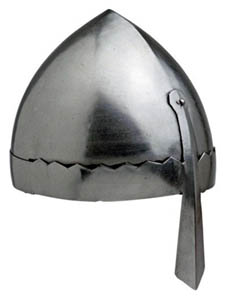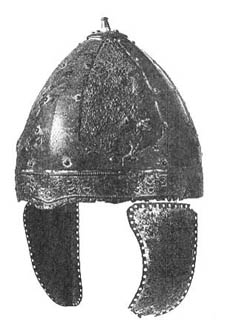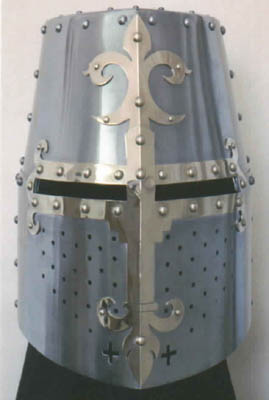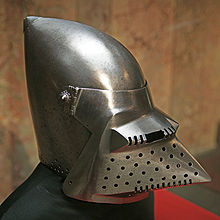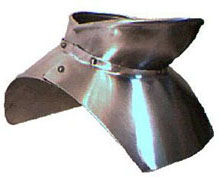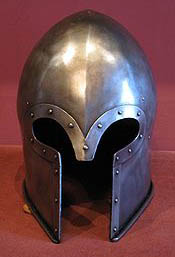Mail, or chainmail, made of interlocking iron rings, which may be riveted or welded shut is believed to have been invented in Eastern Europe about 500 BC. Gradually, small additional plates or discs of iron were added to the mail to protect vulnerable areas. Hardened leather and splinted construction were used for arm and leg pieces. A coat of plates was developed, an armour made of large plates sewn inside a textile or leather coat.
Early plate in Italy, and elsewhere in the 13th–15th century were made of iron. Iron armour could be carburised or case hardened to give a surface of harder steel. Plate armour became cheaper than mail by the 15th century as it required less labour and labour had become much more expensive after the Black Death, though it did require larger furnaces to produce larger blooms. Mail continued to be used to protect those joints which could not be adequately protected by plate, such as the armpit, crook of the elbow and groin. Another advantage of plate was that a lance rest could be fitted to the breast plate.
The small skull cap evolved into a bigger true helmet, the bascinet, as it was lengthened downward to protect the back of the neck and the sides of the head. Additionally, several new forms of fully enclosed helmets were introduced in the late 1300s.
Probably the most recognised style of armour in the World became the plate armour associated with the knights of the European Late Middle Ages, but continuing to the early 17th century Age of Enlightenment in all European countries.
By about 1400 the full harness of plate armour had been developed in armouries of Lombardy. Heavy cavalry dominated the battlefield for centuries in part because of their armour.
In the early 15th century, advances in weaponry allowed infantry to defeat armoured knights on the battlefield. The quality of the metal used in armour deteriorated as armies became bigger and armour was made thicker, necessitating breeding of larger cavalry horses. If during the 14–15th centuries armour seldom weighed more than 15kgs, than by the late 16th century it weighed 25 kg. The increasing weight and thickness of late 16th century armour therefore gave substantial resistance.
|
In the early years of low velocity firearms, full suits of armour, or breast plates stopped bullets fired from a modest distance. Crossbow bolts would seldom penetrate good plate, nor would any bullet unless fired from close range. In effect, rather than making plate armour obsolete, the use of firearms stimulated the development of plate armour into its later stages. For most of that period, it allowed horsemen to fight while being the targets of defending arquebuseers without being easily killed. Full suits of armour were worn by generals and princely commanders right up to the second decade of the 18th century. It was the only way they could be mounted and survey the overall battlefield with safety from distant musket fire. The horse was afforded protection from lances and infantry weapons by steel plate barding. This gave the horse protection and enhanced the visual impression of a mounted knight. Late in the era, elaborate barding was used in parade armour. |
|
Gradually starting in the mid 16th century, one plate element
after another was discarded to save weight for foot soldiers.
Back and breast plates continued to be used throughout the
entire period of the 18th century and through Napoleonic
times, in many European (heavy) cavalry units, until the
early 20th century. From their introduction, muskets could
pierce plate armour, so cavalry had to be far more mindful
of the fire.
Though the age of the knight was over, armour continued to be used in many capacities. Soldiers in the American Civil War bought iron and steel vests from peddlers (both sides had considered but rejected body armour for standard issue). The effectiveness of the vests varied widely- some successfully deflected bullets and saved lives but others were poorly made and resulted in tragedy for the soldiers. In any case the vests were abandoned by many soldiers due to their weight on long marches as well as the stigma they got for being cowards from their fellow troops.
At the start of World War I, thousands of the French Cuirassiers rode out to engage the German Cavalry who likewise used helmets and armour.
Nasal Helm
|
The nasal helmet is a type of combat helmet used from the Early Middle Ages until the High Middle Ages. The nasal helmet was a form of helmet with a domed or raised centre, usually formed around a basic skull-cap design, with a single protruding strip that extended down over the nose to provide additional facial protection. The helmet appeared throughout Europe late in the 9th century, and became the predominant form of head protection, replacing the previous pudding-bowl design, and the Vendel-style spectical helm. One of the earliest versions of the nasal helm is the Vasgaard Helmet. The Bayeux Tapestry features many such helmets, it being the most popular form of protection at the time. The helmet began to lose popularity at the end of the 12th century to helmets that provided more facial protection, and although the nasal helm lost popularity amongst the higher classes of knights and men-at-arms, they were still seen amongst archers to whom a wide field of vision was crucial. The helmet can also be viewed throughout the Maciejowski Bible as a minority item for cavalrymen, giving the impression that it had become uncommon (though not unknown) by the mid-thirteenth century. Nasal helmets have been found of both one-piece and Spangenhelm construction, with the later period helmets being made of a single, smooth raised dome to allow weapons to glance off with ease. The Spangenhelm was a popular European war combat helmet design of the Early Middle Ages. The name is of German origin. Spangen refers to the metal strips that form the framework for the helmet and could be translated as clips. The strips connect three to six steel or bronze plates. The frame takes a conical design that curves with the shape of the head and culminates in a point. The front of the helmet may include a nose protector (a nasal). Older spangenhelms often include cheek flaps made from metal or leather. Spangenhelms may incorporate mail as neck protection, thus forming a partial aventail. Some spangenhelms include eye protection in a shape that resembles modern eyeglass frames. Other spangenhelms include a full face mask. The spangenhelm originated in Central Asia and Ancient Persia, arriving in Europe by way of what is now southern Russia and Ukraine, spread by nomadic Iranian tribes such as the Scythians and Sarmatians who lived among the the Eursian steppes. By the 6th century it was the most common helmet design in Europe and in popular use throughout the Middle East. It remained in use at least as late as the 9th century. The spangenhelm was an effective protection that was relatively easy to produce. Weakness of the design were its partial head protection and its jointed construction. It was replaced by similarly shaped helmets made with one-piece skulls (nasal helms), kettle hats and eventually the Great helm or casque. |
|
Great Helm
|
The great helm or heaume, also called pot helm, bucket helm and barrel helm, of the High Middle Ages arose in the late twelfth century in the context of the crusades and remained in use until the fourteenth century. They were used by knights and heavy infantry in most European armies between about 1220 to 1540 AD. In its simplest form, the great helm was a flat-topped cylinder of steel that completely covered the head and had only very small openings for the eyes and mouth. Later designs gained more of a curved design, particularly on the top, to deflect or lessen the impact of blows. The style is sometimes referred to as a 'crusader helmet', but also as a 'pot helm', and a later variant with a more conical top is known as a 'sugarloaf helm'. In Spanish they are called yelmo de Zaragoza, referring to Saragossa where they were introduced for the first time in the Iberian peninsula. Although the great helm offered greater protection than previous helmets, such as the nasal helm and spangenhelm, it limited the wearer's vision to some extent, and provided poor ventilation. A knight might wear the close-fitting steel skull cap known as a cervelliere, or its later development the bascinet beneath the great helm. A great helm may have also an attached mail collar, or camail, to protect the wearer's neck, throat, and shoulders. The bascinet evolved from its early skull cap form to supersede the great helm for combat. The great helm fell into disuse during the 15th century, however it was used commonly in tournaments where a version of the great helm, the a frog-mouthed tilting helm, evolved. |
|
Bascinet
|
The earliest versions of the bascinet, at the beginning of the 14th century, had no visors, and were worn underneath larger "great helms." After the initial clash of lances, the great helm was often discarded during fierce hand-to-hand combat, as it impeded breathing and vision. Thus, having a smaller helmet underneath was a real advantage. Small "nasals" were developed to protect the nose and part of the face after the great helm was discarded. By the middle of the 14th century, most knights discarded the great helm altogether in favor of a fully visored bascinet. The visor was often conical, giving the appearance of a muzzle or a beak. They were sometimes called "dog faced" (medievally known as a hounskull) or "pig faced" (a common modern term). The early versions sometimes had a neck defence of mail called a camail or aventail, while later versions (at the end of the 14th century) often protected the neck with a separate but attached plate assembly, the gorget. The aventail was attached to a leather band, which was in turn attached to the lower border of the bascinet by a series of staples called vervelles. Holes in the leather band were passed over the vervelles, and a waxed cord was passed through the holes in the vervelles to secure it. |
|
The helmet also had a series of small holes around the bottom edge of the helmet and the face hole. These holes were used to sew a padded liner inside the helmet. The liner was made of linen or a linen blend cloth stuffed with wool or horsehair. The top of the liner was a series of lobes which were gathered by a cord to adjust how high the helmet rode on the wearer's head. While no known chin straps were used, the bascinet was often prevented from being lifted off the wearer's head by tying or strapping the camail to the surcoat or armour.
The bascinet, both with and without a visor (visors were often removable for better visibility and ventilation), was the most common helmet worn in Europe during the latter portions of the 14th and early 15th century, including during the Hundred Years' War. Contemporary illustrations show nearly every knight and man-at-arms wearing one of a few variants of the basic hounskull helmet. The basic design was intended to direct blows from weapons downward and away from the skull and face of the wearer.
Over the course of the late 1300s to early 1400s, the bascinet evolved from a shorter form with a shorter point (or no point at all) to its more pointed form—some so severe as to have a vertical back. In Germany a more bulbous version also appeared in the beginning of the 15th century. During the first half of the 15th century, more plates were added to protect the throat better, producing a form called the "great bascinet". Both the portion covering the skull and the hinged visor over the face became less angular and more rounded, until by the mid- to late 1400s, the great bascinet had evolved into the armet.
Two styles of attaching the visor existed. The "klappvisor" was a single hinge at the front of the forehead that was commonly seen in Germany. The side-pivot mount used two pivots on the side of the helmet, which connected to the visor with hinges to compensate for the lack of parallelism in the pivots. The side-pivot system was commonly seen in Italian armours. Some seasoned knights often wore their bascinets without visors for better visibility and breathing during hand-to-hand combat, and to avoid heat exhaustion.
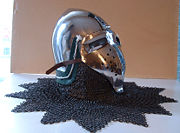
![]() An
aventail or camail is a flexible curtain of chainmail on
a helmet, that extends to cover the neck and shoulders.
The mail could be attached to the helm by threading a leather
cord through brass rings at the edge of the helm. Aventails
were most commonly seen on bascinets in the 14th century
and served as a replacement for a chainmail coif. Some aventails
were decorated with edging in brass or bronze links, or
dagged edges. By the late 15th century, the Aventail had
replaced the chainmail coif completely. Only those who were
poor or who were collectors of the sort had a chainmail
coif. Aventails were typically attached to the helmet via
small staples known as vervelles.
An
aventail or camail is a flexible curtain of chainmail on
a helmet, that extends to cover the neck and shoulders.
The mail could be attached to the helm by threading a leather
cord through brass rings at the edge of the helm. Aventails
were most commonly seen on bascinets in the 14th century
and served as a replacement for a chainmail coif. Some aventails
were decorated with edging in brass or bronze links, or
dagged edges. By the late 15th century, the Aventail had
replaced the chainmail coif completely. Only those who were
poor or who were collectors of the sort had a chainmail
coif. Aventails were typically attached to the helmet via
small staples known as vervelles.
Sallet
|
The sallet (also called salade and schaller) was a war helmet that replaced the bascinet in northern Europe and Hungary during the mid-15th century. Some sallets were close fitting except at the back of the head where they extended and formed a pointed tail. Some Italian ones followed the shape of the neck, and had an additional plate riveted on. Many sallets were worn with an extended, padded, gorget called a bevor that protected the wearer's jaw. Some sallet versions have occularia in the form of a slit in a visor, some have this slit in the front of the helm, or even in the brim. Most sallets needed no breathing holes, as there was a natural gap where it overlapped the bevor near the wearer's mouth. Some Italian sallets had a "bellows visor" with breaths cut into the visor. This helmet design contrasted with the barbute which was popular in Italy at the same time. Unlike the sallet, the barbute itself protected the jaw and neck. So whereas the gorget or bevor were important counterparts to the sallet, they were usually absent in barbutes. Barbutes did not pivot. Sallets did not share the barbute's resemblance to classical Greek or Roman artifacts. One characteristic that distinguishes early sallets from late sallets is the length of the helmet tail, which became more pronounced toward the end of the century. Some helmets are of intermediate design, incorporating elements of both the barbute and the sallet. In the early 16th century this evolved into the burgonet. A bevor is a piece of plate armour designed to protect the neck. A bevor can be made of a single solid piece or multiple articulated lamés around the neck and chin. The bevor was typically worn in conjunction with a sallet, and later with a burgonet, in a form known as a falling buffe. In both cases the two pieces of armour combined to provide protection for the whole of the head and neck. A gorget was a steel or leather collar also designed to protect the throat. It was a feature of older types of armour and intended to protect against swords and other non-projectile weapons. Later, particularly from the 18th century onwards, the gorget became primarily ornamental, serving only as a symbolic accessory on military uniforms. Barbute A barbute is a visorless war helmet of fifteenth century Italian design, often with distinctive "T" shaped or "Y" shaped opening for the eyes and mouth. The barbute resembles classical Greek helmets and may have been influenced by a renewed interest in ancient artifacts. |
|
Close Helm
|
The close helm was a military helmet worn by knights and other combatants in the late medieval and early renaissance era. It carried a visor that pivoted up and fully enclosed the head and neck area, unlike earlier helms such as the Sallet and Barbute, which sometimes may have left the wearer more exposed, or needed a bevor to be added to protect the chin and neck. The close helm is a helm which is very similar to an armet, but has a different method of opening. While an armet has two cheekpieces, a close helm instead has a kind of bevor, which is attached in the same way to pivots as its visor. The close helmet most probably evolved from a number of different helmets, from the armet, the Italian bellows-visored sallets and possibly hinged Great Bascinets. As a type of helm, they largely appeared in the later 15th century, though there are earlier examples. |
|
The close helm was used in battle, but was also popular in tournaments, where sometimes the visor would be less solid, and instead have bars which would still offer protection but allow more visibility. Close helms for jousting were heavier, weighing up to 12 pounds, while the helms for normal combat were lighter, often around 8 pounds.
The bevor/visor of an armet is split in the middle, with the two halves hinged at the cheek, opening outwards to expose the face of the wearer. The bevor of a 'true' close helm opens by swinging upwards; it is in one piece and shares the pivot point with the visor. The close helm often had a catch to hold the visor down. Both forms of helm may have had a round plate at the back of the helm, a protective rondel, the purpose of which is not truly known, but it is suspected that it protected strapping.
|
|
|
|
|
|
|
|
|
|
|
|
|
|
|
|
|
|
|
|
|
|
|
|
|
|
|
|
|
|
|
|
|
|
|
|
